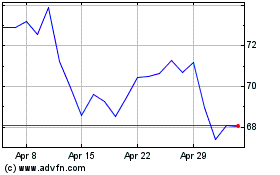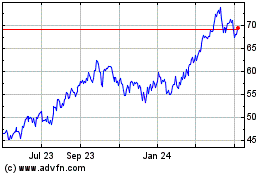Canada Proposes New Oil Sands Environmental Monitoring Plan
March 25 2011 - 12:01PM
Dow Jones News
Canada's federal government proposed a plan to revamp
environmental monitoring in the country's oil sands industry in
response to critics of the current system.
The plan would create a new environmental monitoring framework
to collect water-surface data from several areas around the oil
sands region in northeastern Alberta. The cost, at roughly C$20
million a year, will be borne by oil sands producers.
The regulatory overhaul comes after a recent series of reports
and scientific studies concluded the existing environmental
monitoring system has failed to examine all the sources of
pollution created by the oil sands industry.
The oil sands industry already produces about half of the 1.9
million barrels a day of Canadian oil that is exported to the
United States, and is expected to double in size during this
decade.
But that growth rate partly depends upon the industry's ability
to defend its environmental record. Approval of a key Canadian oil
pipeline that will transport mostly oil sands crude, TransCanada
Corp.'s (TRP) Keystone XL, was delayed this month after the U.S.
State Department asked for more environmental studies.
"We are confident that we can protect the environment while
seeing the economic benefits of the oil sands," Environment
Minister Peter Kent said after unveiling the plan late
Thursday.
The federal government worked with the province of Alberta to
design the new system, which will be a joint effort between the
province and the federal government. Alberta's environment ministry
is expected to unveil its own recommendations for the new system in
June.
Flaws in Alberta's current monitoring system were exposed last
year by University of Alberta water scientist David Schindler. His
work showed that air pollution from the oil sands industry was
settling on snow and then melting into the Athabasca River, and
possibly creating health effects for animals and humans
downstream.
After first insisting that the pollution Schindler uncovered was
naturally present rather than created by industry, the Alberta
government said this year that its monitoring system, a
joint-effort between the provincial government, oil sand companies
and native groups, is inadequate to measure the kind of pollution
that Schindler found.
The first phase of the revamped system will measure water
quality at several points in the Athabasca River and its
tributaries. A later phase will monitor upstream water sources and
air quality. The system will be designed to measure cumulative
effects on the environment and to better isolate which kinds of
pollution are caused by natural oil sands seepage, and which are
created by industrial activity, the government said.
Environmental groups praised the plan and said the federal
government should have a greater role in regulation and
monitoring.
"It's time to stop letting industry do government's job," said
Gillian McEachern, a spokeswoman for the environmental advocacy
group Environmental Defence. "The federal government already has
the tools and jurisdiction to not only collect the right
information, but to create rules that put limits on the pollution
coming from the tar sands and to prosecute offenders," she
said.
-By Edward Welsch, Dow Jones Newswires; 403-229-9095;
edward.welsch@dowjones.com
Imperial Oil (AMEX:IMO)
Historical Stock Chart
From Jun 2024 to Jul 2024

Imperial Oil (AMEX:IMO)
Historical Stock Chart
From Jul 2023 to Jul 2024
